Laboratory Assessment of Selected Protective Coatings Applied on Two Sandstone Types
Abstract
:1. Introduction
2. Materials and Methods
2.1. Materials
2.2. Methods
3. Results
3.1. Basic Physical Properties
3.2. Assessment of Impregnation Coatings
3.2.1. Hořice Sandstone
3.2.2. Malé Skalky Sandstone
4. Discussion
5. Conclusions
Author Contributions
Funding
Institutional Review Board Statement
Informed Consent Statement
Data Availability Statement
Acknowledgments
Conflicts of Interest
References
- Warscheid, T.; Braams, J. Biodeterioration of stone: A review. Int. Biodeterior. Biodegrad. 2000, 46, 343–368. [Google Scholar] [CrossRef]
- Deprez, M.; De Kock, T.; De Schutter, G.; Cnudde, V. A review on freeze-thaw action and weathering of rocks. Earth-Sci. Rev. 2020, 203, 1031–1043. [Google Scholar] [CrossRef]
- Zhao, J.; Meissener, F. Experimental investigation of moisture properties of historic building material with hydrophobization treatment. Energy Procedia 2017, 132, 261–266. [Google Scholar] [CrossRef]
- Vidal, F.; Vicente, R.; Mendes Silva, J. Review of environmental and air pollution impacts on built heritage: 10 questions on corrosion and soiling effects for urban intervention. J. Cult. Herit. 2019, 37, 273–295. [Google Scholar] [CrossRef]
- Singh, M. Coal Bottom Ash. In Waste and Supplementary Cementitious Materials in Concrete: Characterisation, Properties and Applications; Siddique, R., Cachim, P., Eds.; Woodhead Publishing Series in Civil and Structural Engineering; Woodhead Publishing: Sawston, UK, 2018; pp. 3–50. [Google Scholar]
- Karagiannis, N.; Karoglou, M.; Bakolas, A.; Moropoulou, A. Effect of temperature on water capillary rise coefficient of building materials. Build. Environ. 2015, 106, 402–408. [Google Scholar] [CrossRef]
- Soulios, V.; de Place Hansen, E.J.; Feng, C.H.; Janssen, H. Hygric behavior of hydrophobized brick and mortar samples. Build. Environ. 2020, 176, 106843. [Google Scholar] [CrossRef]
- Syed, A.; Donadio, M. Silane sealers/Hydrophobic impregnation—The European perspective. Concr. Repair Bull. 2013, 12, 1–6. [Google Scholar]
- Siegesmund, S.; Snethlage, R. (Eds.) Stone in Architecture: Properties, Durability, 4th ed.; Springer: Berlin/Heidelberg, Germany, 2011; pp. 227–304, 511–523. [Google Scholar]
- Varas-Muriel, M.J.; Pérez-Monserrat, E.M.; Vázquez-Calvo, C.; Fort, R. Effect of conservation treatments on heritage stone. Characterisation of decay processes in a case study. Constr. Build. Mater. 2015, 95, 611–622. [Google Scholar] [CrossRef] [Green Version]
- Vacchiano, C.H.D.; Incarnato, L.; Scarfato, P.; Acierno, D. Conservation of tuff-stone with polymeric resins. Constr. Build. Mater. 2008, 22, 855–865. [Google Scholar] [CrossRef]
- Barták, P.; Praženková, M. Hořice sandstone adorns the dominant feature of Berlin. Min. Suroviny 2015, 3, 19–23. (In Czech) [Google Scholar]
- Holzer, R.; Bednarik, M.; Laho, M. Are the rock from Brezovské Carpathians suitable for construction and decorative purposes? Acta Geol. Slovaca 2014, 6, 13–27. (In Slovak) [Google Scholar]
- Munsell Color. Munsell Soil-Color Charts with Genuine Munsell Color Chips; Munsell Color: Grand Rapids, MI, USA, 2010. [Google Scholar]
- Pivko, D. Use of Hořice sandstone and other decorative stones of the Czech Republic in Slovakia. Zpravodaj—Svaz Kameníků a Kamenosochařů České Republiky z.s 2019, 2, 10–14. (In Slovak) [Google Scholar]
- Hornáčková, A. Dobra Voda Sandstone; Trnavská univerzita v Trnave. Typi Univerzitatis Tyrnaviensis: Trnava, Slovakia, 2017; p. 91. (In Slovak) [Google Scholar]
- EN 1926:2007; Natural Stone Test Methods. Determination of Uniaxial Compressive Strength. European Standard: Brussels, Belgium, 2007.
- EN 1936:2007; Natural Stone Test Methods. Determination of Real Density and Apparent Density, and of Total and Open Porosity. European Standard: Brussels, Belgium, 2007.
- EN 13755:2008; Natural Stone Test Methods. Determination of Water Absorption at Atmospheric Pressure. European Standard: Brussels, Belgium, 2008.
- EN 14579:2004; Natural Stone Test Methods. Determination of Sound Speed Propagation. European Standard: Brussels, Belgium, 2004.
- EN 12371:2010; Natural Stone Test Methods. Determination of Frost Resistance. European Standard: Brussels, Belgium, 2010.
- EN ISO 14689:2018; Geotechnical Investigation and Testing. Identification, Description and Classification of Rock. European Standard: Brussels, Belgium, 2018.
- EN 1925:1999; Natural Stone Test Methods. Determination of Water Absorption Coefficient by Capillarity. European Standard: Brussels, Belgium, 1999.
- EN 15801:2009; Conservation of Cultural Property. Test Methods. Determination of Water Absorption by Capillarity. European Standard: Brussels, Belgium, 2009.
- Lu, J.; Wang, K.; Qu, M.L. Experimental determination on the capillary water absorption coefficient of porous building materials: A comparison between the intermittent and continuous absorption tests. J. Build. Eng. 2020, 28, 101091. [Google Scholar] [CrossRef]
- Pan, X.; Shi, Z.; Shi, C.; Ling, T.C.; Li, N. A review on concrete surface treatment Part I: Types and mechanisms. Constr. Build. Mater. 2017, 132, 578–590. [Google Scholar] [CrossRef]
- Ren, K.; Kagi, D. Evaluation of an oil and water repellent on masonry substrates. In Proceedings of the Hydrophobe VIII, Hongkong, China, 7–9 December 2017; Available online: http://www.hydrophobe.org/pdf/hongkong/A-1-3.pdf (accessed on 8 May 2022).
- Frankovská, J.; Durmeková, T. Specific features of weak rock laboratory testing. In Proceedings of the 15th European Conference on Soil Mechanics and Geotechnical Engineering, Athens, Greece, 12–15 September 2011; Anagnostopoulos, A., Ed.; IOS Press: Amsterdam, The Netherlands, 2011; pp. 337–342. [Google Scholar]
- Wu, Z.; Yin, K.; Wu, J.; Zhu, Z.; Duan, J.; He, J. Recent advances in femtosecond laser-structured Janus membranes with asymmetric surface wettability. Nanoscale 2021, 13, 2209–2226. [Google Scholar] [CrossRef]
- Dinçer, I.; Bostanci, M. Capillary water absorption characteristics of some Cappadocian ignimbrites and the role of capillarity on their deterioration. Environ. Earth Sci. 2019, 78, 7. [Google Scholar] [CrossRef]
- Soulios, V.; de Place Hansen, E.J.; Peuhkuri, R.; Moller, E.; Ghanbari-Siakhali, A. Durability of the hydrophobic treatment on brick and mortar. Build. Environ. 2021, 201, 107994. [Google Scholar] [CrossRef]
- Sariisik, A.; Sariisik, G.; Senturk, A. Characterization of Physical and Mechanical Properties of Natural Stones Affected by Ground Water under Different Ambient Conditions. Ekoloji 2010, 19, 88–96. [Google Scholar] [CrossRef]
- Tomašić, I.; Lukić, D.; Peček, N.; Kršinic, A. Dynamics of capillary water absorption in natural stone. Bull. Eng. Geol. Env. 2011, 7, 673–680. [Google Scholar] [CrossRef]
- Durmeková, T.; Adamcová, R.; Maľa, M.; Grand, P. Efficiency of protective coating applied on a highly porous decorative tuff. Acta Geol. Slovaca 2021, 13, 85–94. [Google Scholar]
- Young, M.E.; Cordiner, P.; Murray, M. Chemical consolidants and water repellents for sandstones in Scotland Edinburgh. In Historic Scotland Research Report; Edinburgh Historic Scotland: Edinburgh, UK, 2003; ISBN 1903570204. [Google Scholar]
- Hansen, T.K.; Bjarlov, S.P.; Peuhkuri, R.H.; Hansen, K.K. Performance of hydrophobized solid masonry—Experimental approach. Constr. Build. Mater. 2018, 188, 695–708. [Google Scholar] [CrossRef]
- Bao, J.; Li, S.; Zhang, P.; Xue, S.; Cui, Y.; Zhao, T. Influence of exposure environments and moisture content on water repellency of surface impregnation of cement-based materials. J. Mater. Res. Technol. 2020, 9, 12115–12125. [Google Scholar] [CrossRef]
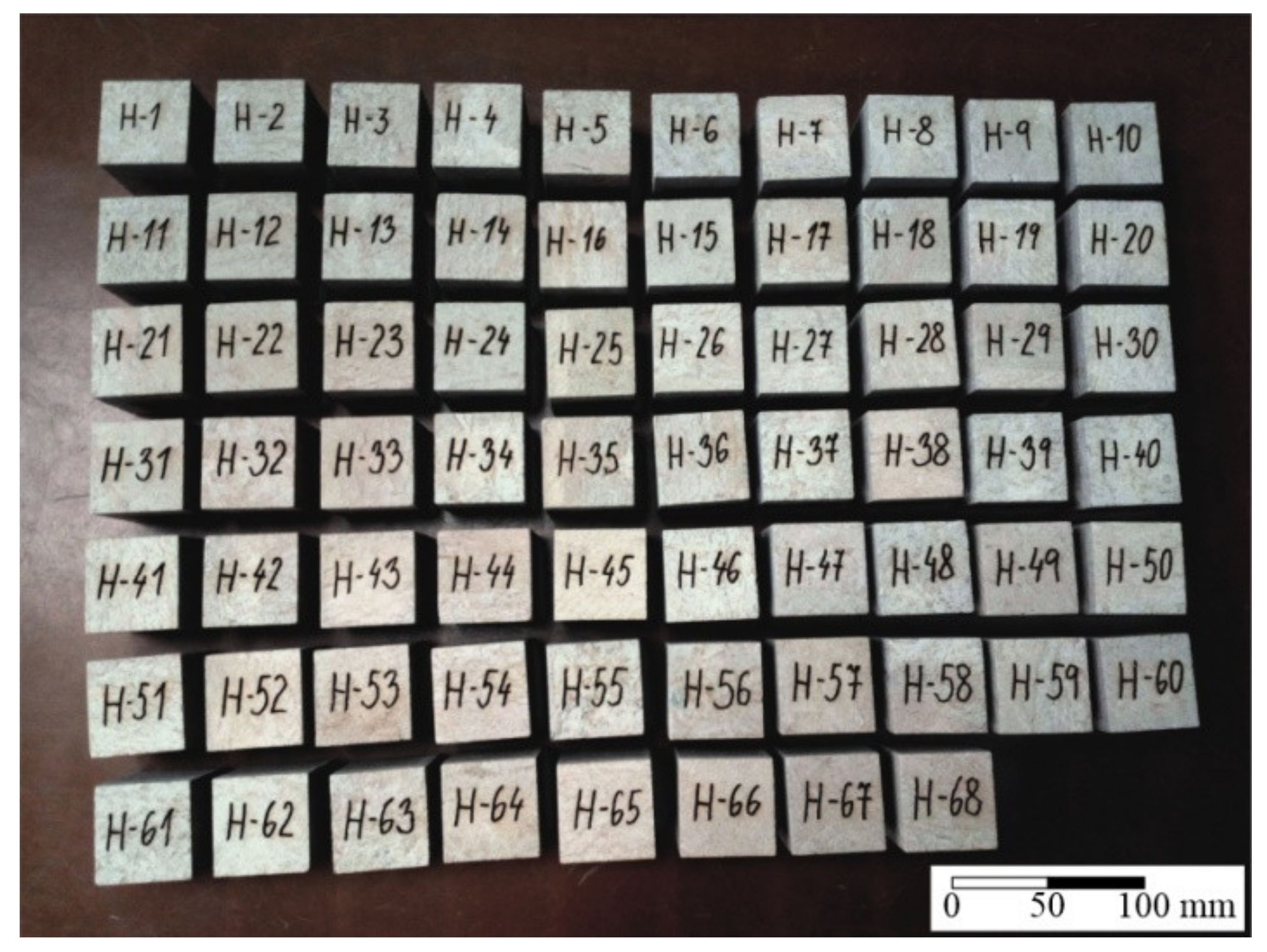
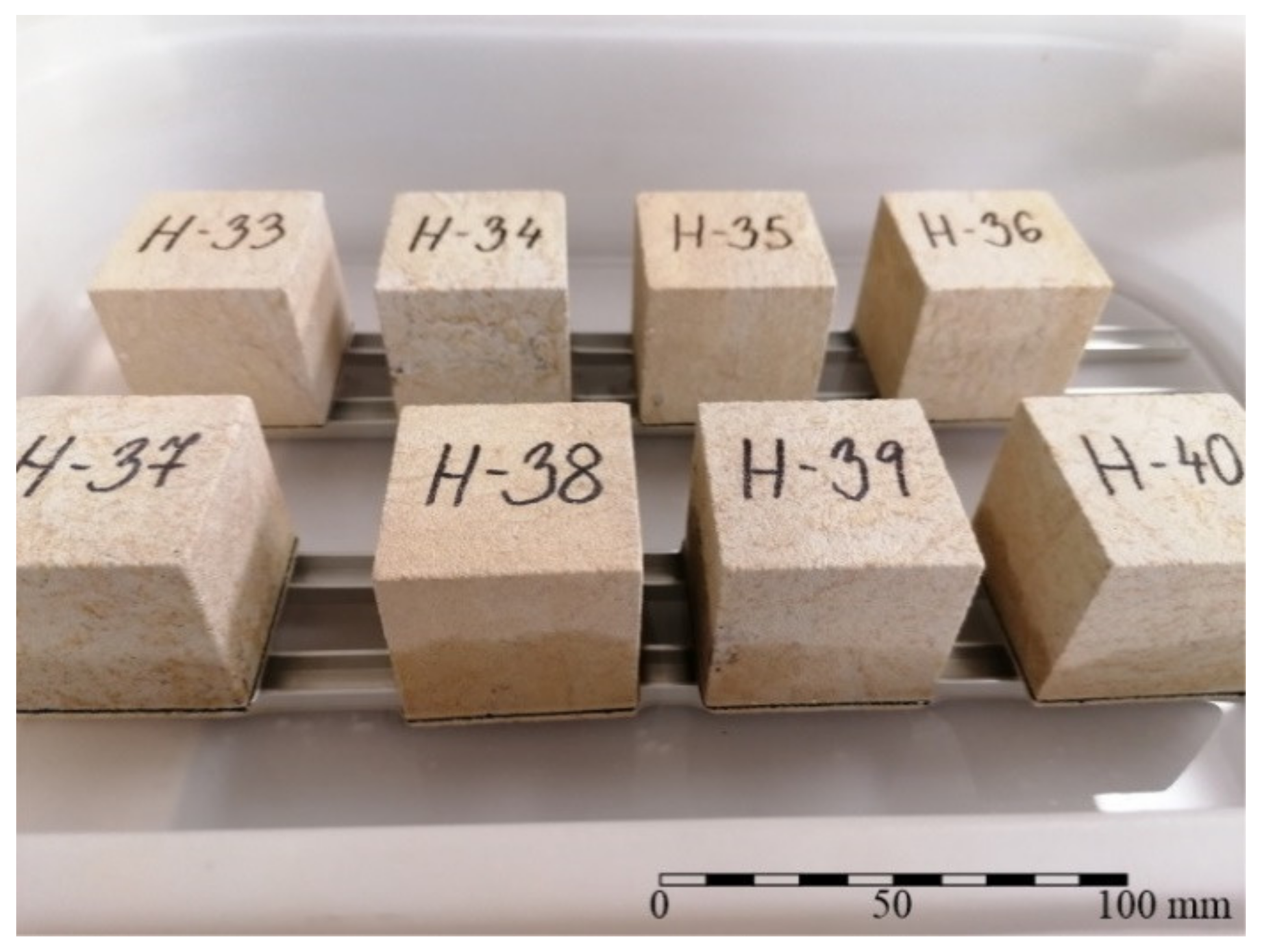
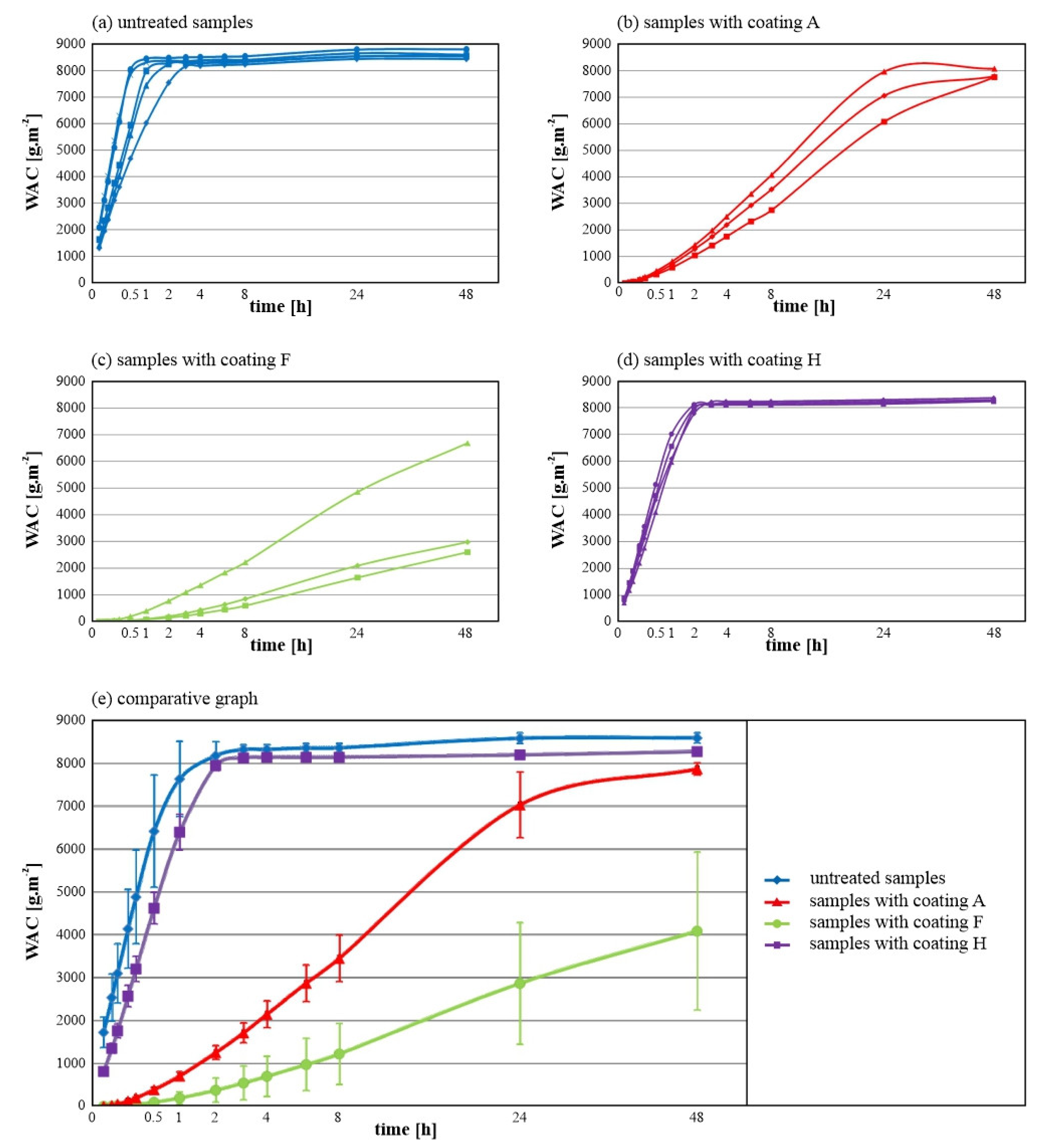
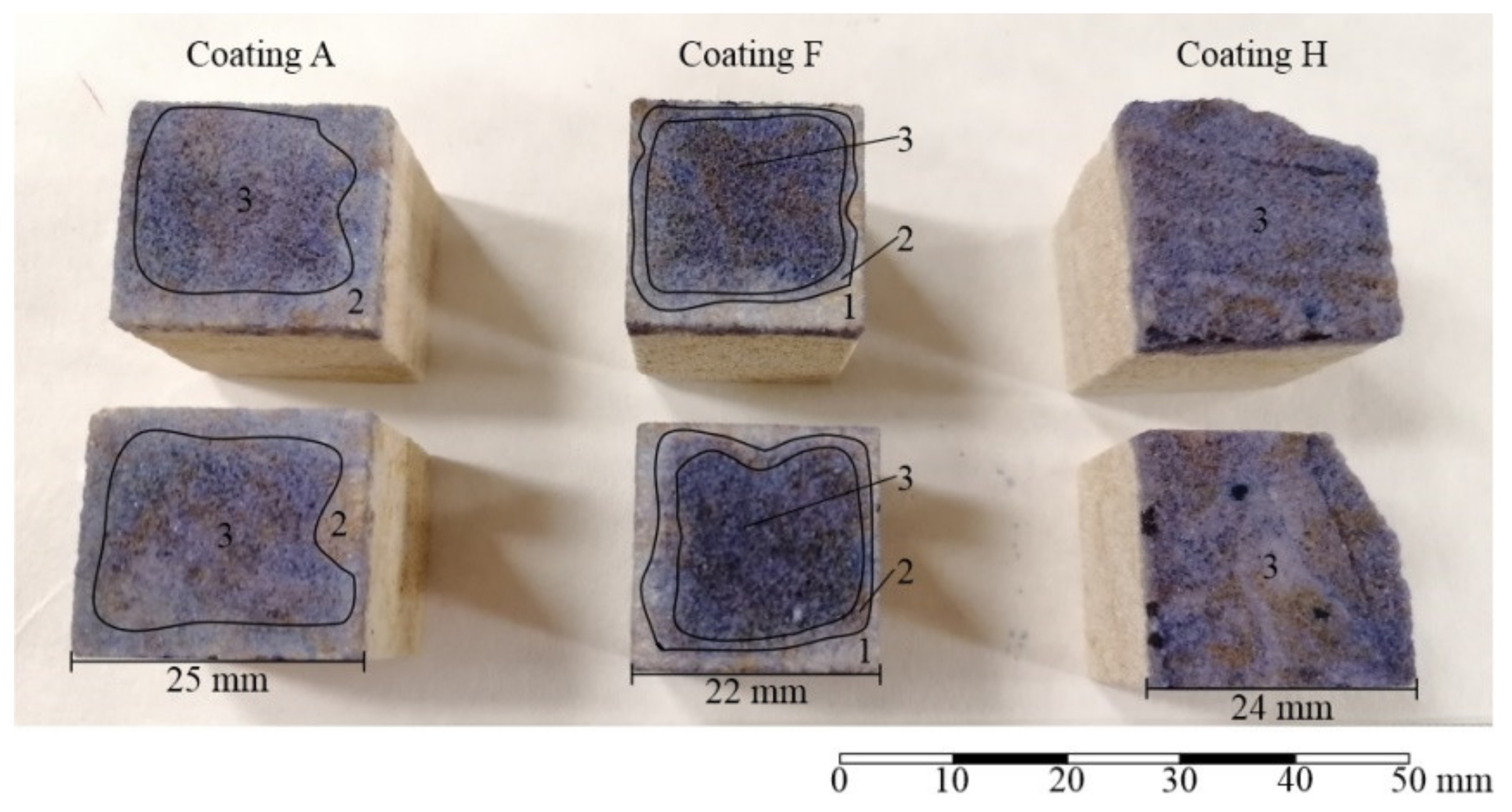
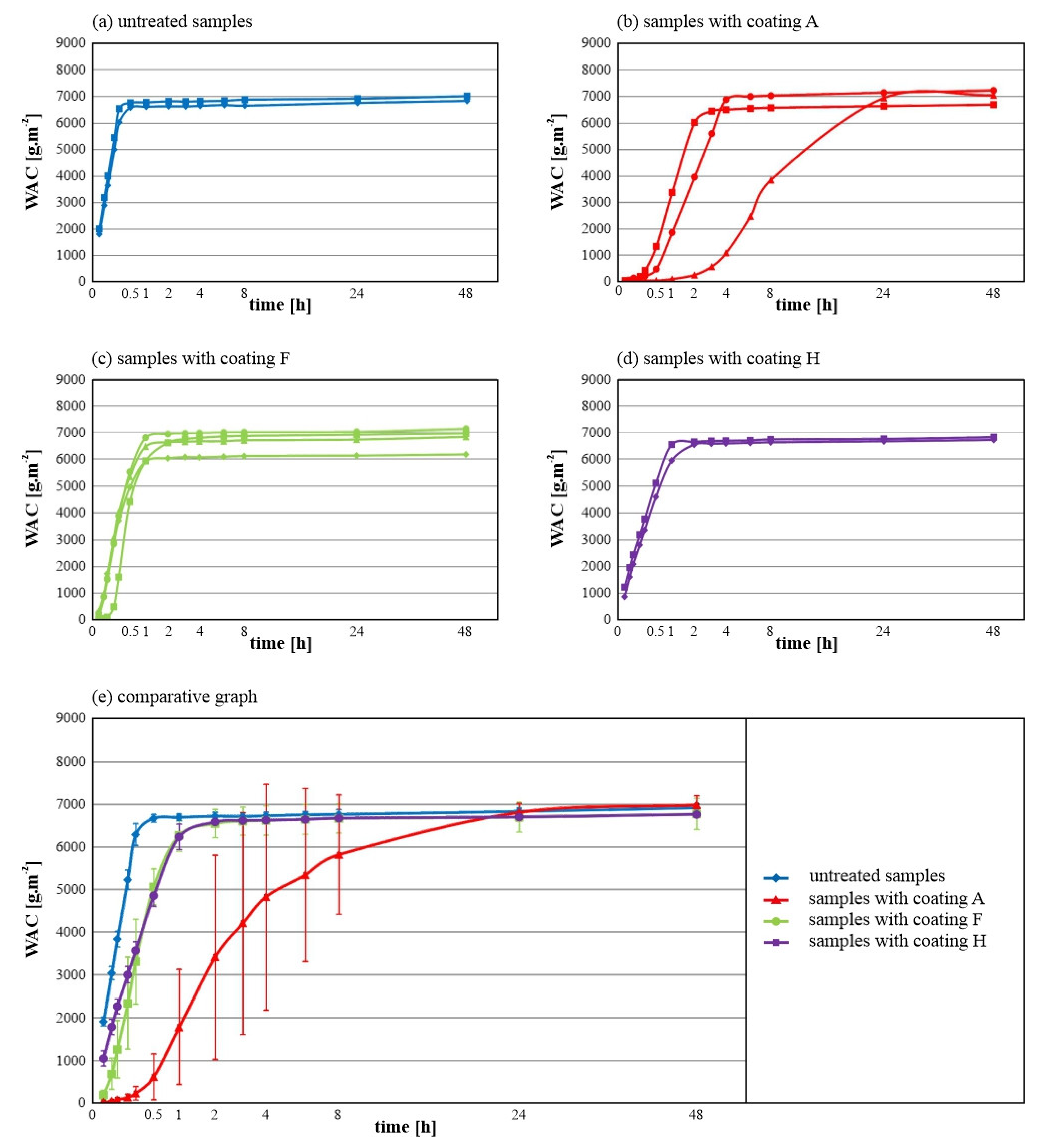
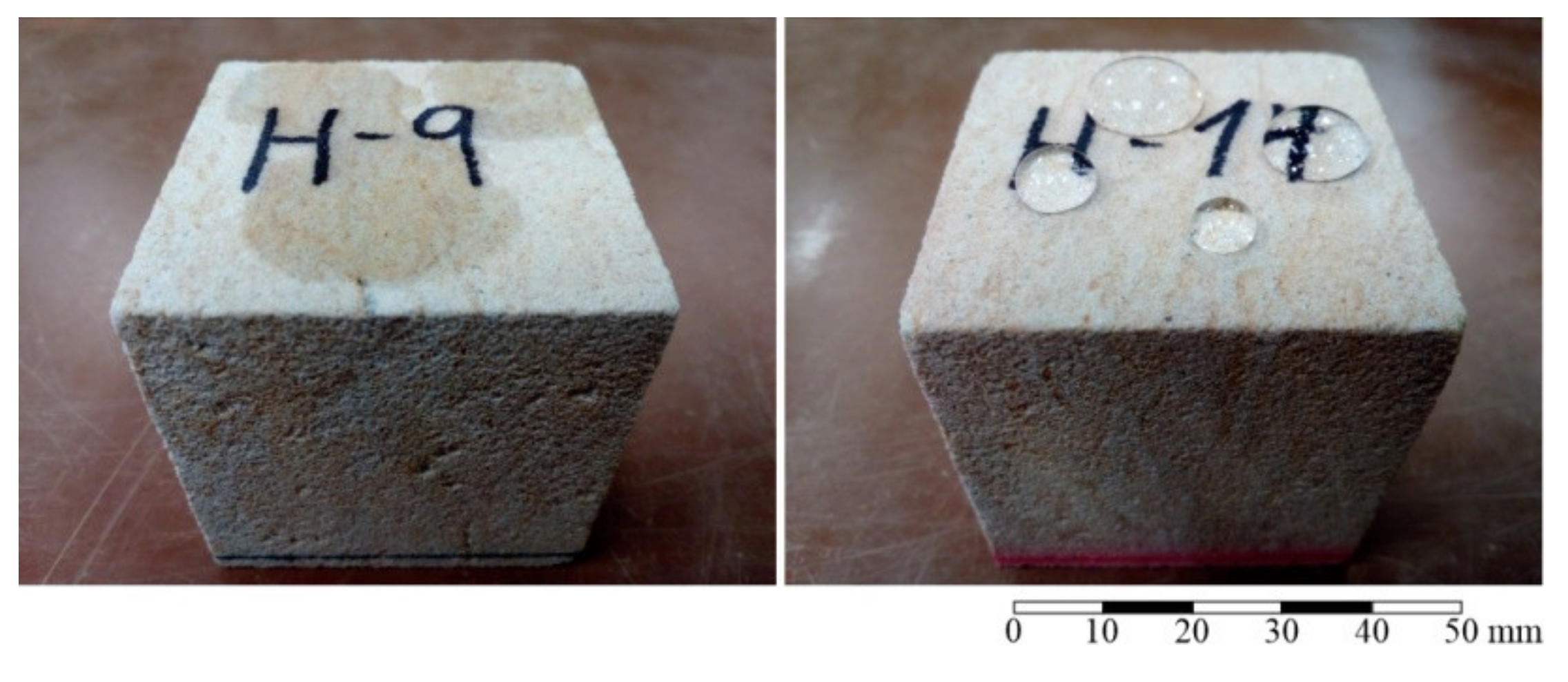
| Sandstone Type | Hořice (HS) | Malé Skalky (MS) |
|---|---|---|
| Quarry location | Podhorní Újezd, Czech Republic | Chtelnica, Slovakia |
| Geological unit | Bohemian Cretaceous Basin [12] | Dobrá Voda Depression [13] |
| Age | Mesozoic–Upper Cretaceous [12] | Terciary–Neogene [13] |
| Lithological type | Quartz sandstone/Arenite | Carbonate sandstone |
| Colour in fresh state | Very pale brown (10YR8/2) with characteristic darker rusty streaks [14] | Very pale brown (10YR8/2), homogeneous color [14] |
| Texture | Fine grained | Fine grained |
| Isotropy/Anisotropy | Isotropic | Isotropic |
| Figure of sandstone | 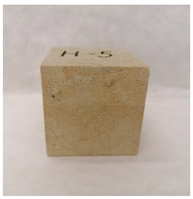 | 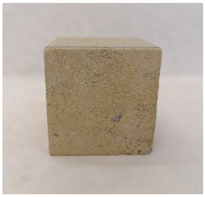 |
| Property/Sandstone Type | HS | MS |
|---|---|---|
| Bulk density ρd [kg.m−3] | 1931 | 2196 |
| Particle density ρs [kg.m−3] | 2612 | 2733 |
| Total porosity n [%] | 26.07 | 19.65 |
| Open porosity no [%] | 18.30 | 15.82 |
| Water absorption by total immersion WAI [%] | 9.48 | 7.21 |
| Degree of saturation after total immersion Sr [%] | 70.21 | 80.54 |
| Uniaxial compressive strength UCS [MPa] | 29.9 | 20.6 |
| Ultrasonic P-waves velocity Vp [km.s−1] | 2.23 | 2.74 |
| Parameters | Types of Samples | Before Test | After Test |
|---|---|---|---|
| Bulk density ρd [kg.m−3] | untreated | 1931 | 1928 |
| with coating F | 1937 | 1924 | |
| with coating A | 1926 | 1921 | |
| with coating H | 1919 | n | |
| Total porosity n [%] | untreated | 26.07 | 26.20 |
| with coating F | 25.86 | 26.34 | |
| with coating A | 26.25 | 26.46 | |
| with coating H | 26.54 | n | |
| Open porosity no [%] | untreated | 18.30 | 21.37 |
| with coating F | 17.71 | 22.04 | |
| with coating A | 18.43 | 21.15 | |
| with coating H | 18.02 | n | |
| Water absorption by total immersion WAI [%] | untreated | 9.48 | 11.08 |
| with coating F | 9.15 | 11.46 | |
| with coating A | 9.57 | 11.01 | |
| with coating H | 9.47 | n | |
| Degree of saturation Sr [%] | untreated | 70.21 | 81.56 |
| with coating F | 68.48 | 83.67 | |
| with coating A | 70.19 | 79.94 | |
| with coating H | 70.15 | n | |
| Uniaxial compression strength UCS [MPa] | untreated | 29.9 | 24.9 |
| with coating F | n | 28.3 | |
| with coating A | n | 28.8 | |
| with coating H | n | n |
| Sample | WAIn | ||
|---|---|---|---|
| Before (A) | After (B) | A:B [-] | |
| untreated | 0.5178 | 0.6056 | 0.86 |
| with coating F | 0.5164 | 0.6478 | 0.80 |
| with coating A | 0.5191 | 0.5976 | 0.87 |
| with coating H | 0.5212 | n | n |
| Parameters | Types of Samples | Before Test | After Test |
|---|---|---|---|
| Bulk density ρd [kg.m−3] | untreated | 2196 | 2190 |
| with coating F | 2192 | 2189 | |
| with coating A | 2162 | 2161 | |
| with coating H | 2187 | 2191 | |
| Total porosity n [%] | untreated | 19.65 | 19.86 |
| with coating F | 19.79 | 19.90 | |
| with coating A | 20.88 | 20.91 | |
| with coating H | 20.00 | 19.83 | |
| Open porosity no [%] | untreated | 15.82 | 17.19 |
| with coating F | 15.76 | 15.47 | |
| with coating A | 17.16 | 16.92 | |
| with coating H | 15.73 | 16.32 | |
| Water absorption by total immersion WAI [%] | untreated | 7.21 | 7.85 |
| with coating F | 7.18 | 7.07 | |
| with coating A | 7.92 | 7.83 | |
| with coating H | 7.19 | 7.45 | |
| Degree of saturation Sr [%] | untreated | 80.54 | 86.59 |
| with coating F | 79.35 | 77.76 | |
| with coating A | 81.98 | 80.96 | |
| with coating H | 78.60 | 82.29 |
| Sample | WAIn | ||
|---|---|---|---|
| Before (A) | After (B) | A:B [-] | |
| untreated | 0.4554 | 0.4961 | 0.92 |
| with coating F | 0.4551 | 0.4495 | 1.01 |
| with coating A | 0.4615 | 0.4569 | 1.01 |
| with coating H | 0.4569 | 0.4733 | 0.97 |
Publisher’s Note: MDPI stays neutral with regard to jurisdictional claims in published maps and institutional affiliations. |
© 2022 by the authors. Licensee MDPI, Basel, Switzerland. This article is an open access article distributed under the terms and conditions of the Creative Commons Attribution (CC BY) license (https://creativecommons.org/licenses/by/4.0/).
Share and Cite
Dunčková, L.; Durmeková, T.; Adamcová, R.; Bednarik, M. Laboratory Assessment of Selected Protective Coatings Applied on Two Sandstone Types. Coatings 2022, 12, 761. https://doi.org/10.3390/coatings12060761
Dunčková L, Durmeková T, Adamcová R, Bednarik M. Laboratory Assessment of Selected Protective Coatings Applied on Two Sandstone Types. Coatings. 2022; 12(6):761. https://doi.org/10.3390/coatings12060761
Chicago/Turabian StyleDunčková, Lucia, Tatiana Durmeková, Renáta Adamcová, and Martin Bednarik. 2022. "Laboratory Assessment of Selected Protective Coatings Applied on Two Sandstone Types" Coatings 12, no. 6: 761. https://doi.org/10.3390/coatings12060761
APA StyleDunčková, L., Durmeková, T., Adamcová, R., & Bednarik, M. (2022). Laboratory Assessment of Selected Protective Coatings Applied on Two Sandstone Types. Coatings, 12(6), 761. https://doi.org/10.3390/coatings12060761






